Harvesting
Harvesting Inventory
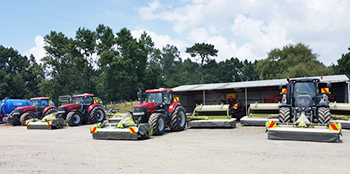
Mowers
2 x Claas triples with tine conditioners and groupers. 1 claas triple roller conditioner

Rakes
2 x Claas 4 rotor rakes, 1 class 2 rotor rake, 1 lely 6m tedder
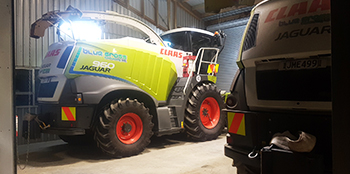
Harvesters
3 x Claas 960/2016 fine chop harvesters

Baler
1 KUHN roller combo round baler
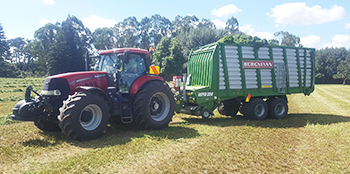
Loader/ Wagon
1 Bergmann Repex 33 K wagon
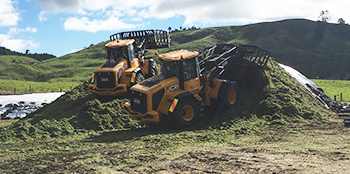
Stackers
3 x JCB 435 Farmaster wheel loaders, Fendt 926, 2 x Valtra 270 S, 2 x Case Puma 230
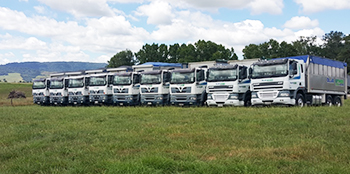
Cartage Units
11 Truck and Trailer units, 4 Truck only, 4 Tractor and trailer units
Harvesting Annuals, Perennials, Lucerne and Maize is an important part of our operations. We consider it’s a very important part of the agriculture industry that requires excellence. The added value created from accuracy of timing and accuracy of operation and understanding the key factors in the ensiling process are of extreme importance to achieve maximum product value.
Our fine chop harvesters are always of latest models and technology as the current pair are 2015 models.
Our Baler is a KUHN Roller combo known for tight centres and a high density bale to ensure excellent ensiling in an aerobic free environment.
Bergmann Loader/wagon is a high capacity harvesting system that consistently has an excellent chop length of around 50mm with full set of knives. The advantages of consistent chop length are better and more consistent compaction result.
Our compaction tractors are JCB 345model 15ton rubber tyre loaders equipment on single wheels to give very high psi. pressure. Large 15ton wheel tractors are also available to always ensure maximum compaction will be achieved.
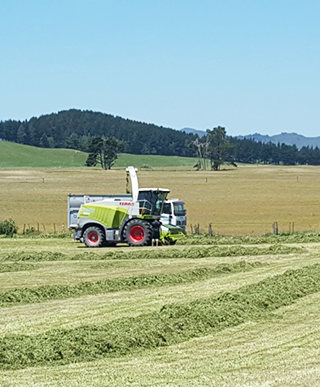
Grass Silage
the ability to lower moisture content out of direct sun light in as quick a time as possible. Exposure to air and sun light allows aerobic bacteria to consume the grass sugars etc. from the moment its cut until sealed in a silage stack and the PH has lower to around 3.
Blue Grass advocates high quality inoculant to assist in the ensiling process. Blue Grass also has available annual grass varieties available as a silage product Sept.- Oct. Large volumes of perennial grass are also available as hay or silage as bulk or bales from Nov. onwards.
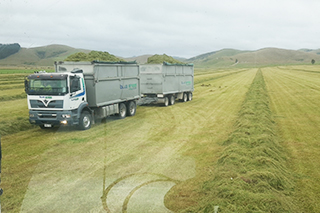
Lucerne
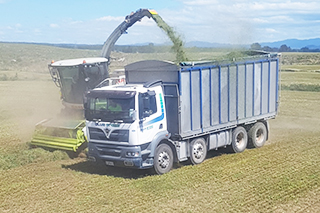
We believe we have the knowledge, expertise and specialized equipment for those that have an interest in developing the crop for their own usage or as a high value feed crop to sell. In approx. 2004 Palm Kernel was promoted as an easy and convenient source of protein.
Palm Kernel can never compete with Lucerne as a source of protein to balance a diet as its protein percentage level is below the diet protein percentage level required. Therefore, feeding 100% PK will not give the desired diet protein percentage required.
Farmers environmental and global warming concerns has reinvigorated the demand for Lucerne. Blue Grass has a large acreage of Lucerne it harvests and sells every year to the dairy industry.
Maize
4 stack tractors/rubber tyre loaders all in the 15 tonne bracket to ensure excellent compaction.
On farm harvesting or bought in product are major parts of our operation.
Blue Grass has available a large tonnage of maize silage from Contract Growers. Blue Grass also has a large demand from farmers for extra supplement feeds. Cultivation; refer to Cultivation section for many maize cultivation options and systems.
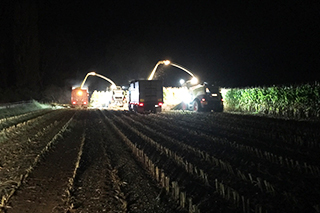
When Margins Are Minimal
The value of good advice or the cost of bad advice
Do you go for higher production or do you just save costs?
We argue the real value is in accurate advice with accurate performance.
Ask an expert a question
Alvaro Garcia
DVM PhD, Dairy Science Department
South Dakota State University
DVM PhDMaize silage at 10.6 MJ ME/Kg and Maize silage at 11.6 MJ ME/Kg
The difference is 1 MJ ME/ Kg, or a 1000 MJ ME per metric ton dm.
At 5 MJ ME per kg fluid milk there is 200kg energy equivalent milk per ton of silage DM.
For every unit of MJ ME per Kg, A ton of better quality silage represents an additional energy equivalent of 200 kg fluid milk. (A kg of fluid milk is approx. 1 litre of milk)
At 8.3% ms/litre, a ton of better silage represents 16.6 kg ms per ton
@ $5 = $83.00 extra profit per ton of maize silage = 8.3cents kgdm
@ 22t/ha = $1826/ha or $8300 for every 100t dm maize purchased.
EXTRA PROFIT
The benefit of accurate ensiling to ensure your silage is well compacted with high quality inoculant is all about keeping stack temperatures lower and for a shorter period. Every extra degree in temperature or longer periods of heat is seriously destroying availability of ME and protein. Compost can test excellent in ME and protein with zero availability.
Too often a fert rep, a stock and station rep or even a farm consultant is asked who’s a good contractor, and they will say, so and so is cheaper. I say bad advice costs you a lot of money. If you have to cut the price to get work, there is a good reason for that.
What makes a producer money is the quality of your maize and grass silage, the quality of your cultivation in protecting your soil, the quality of the genetics of any plantings, the quality of equipment and staff, the service or response you receive from your contractor ie. The availability or being always contactable.
All of the above add value while the final part of the equation” the cheapest price” is about saving you money.
An accurate quality contractor will make you more than you save.
We have a client producing over 2 million milk solids with high supplement input. The reason this works well is the high-quality supplement inputs
Old Mate Would Say
“You get nothing for nothing”
Young Guns Say
“Poor quality costs you dearly”
Measuring The Quality Of The Ensiling Process
The quality of the ensiling process can be assessed immediately upon the opening of the stack. Odour, Colour and silage Effluent are all indicators of poor quality silage from poor ensiling process. Excellent silage will have little odour; be of light colour and no silage effluent:
Tobacco like smell indicates excessive heat, pungent odour indicates foreign bacteria, and silage effluent indicates very high heat over a long period.
Every degree of excessive heat compounded by the period of the heat, depletes availability or digestibility of carbohydrates and protein.
Compost may have high levels of ME, but is totally indigestible. Heat is generated from oxygen, high levels of aerobic bacteria and the consumption of sugars (carbohydrates/ME).
For high quality ensiling, you require: Good compaction to remove oxygen, and high quality inoculant to lower PH as fast as possible to destroy aerobic bacteria, and to slowing consumption of sugars. Also, a clean dirt-free environment. Well sealed and firmly held cover sheets are essential to ensile and store silage.
